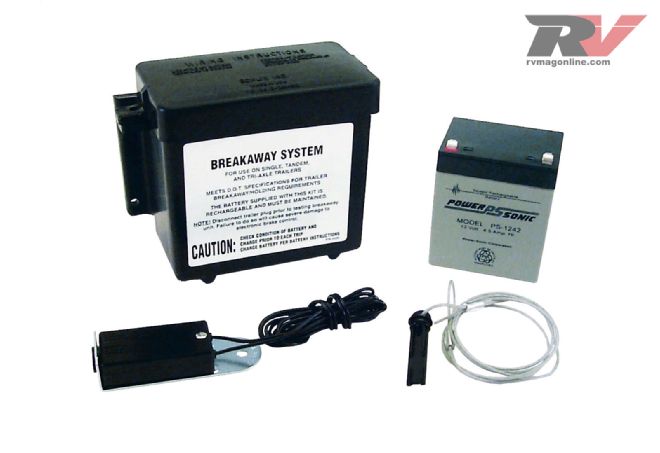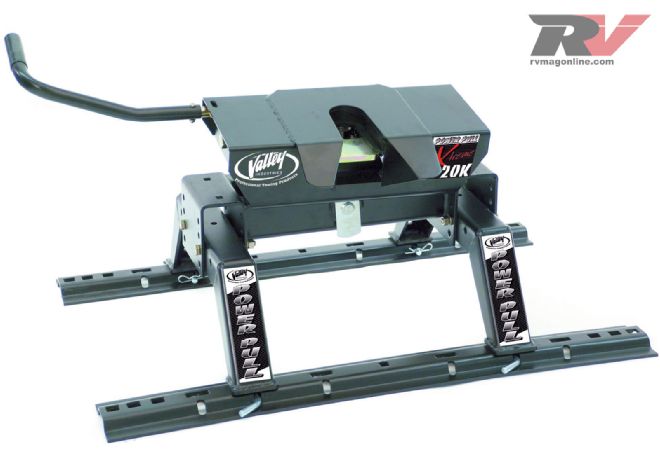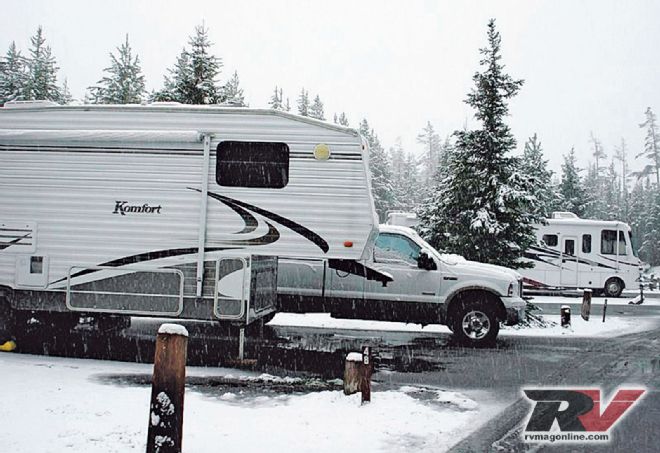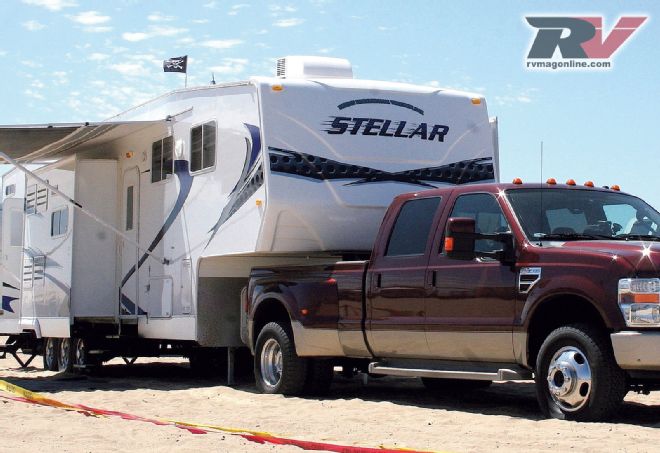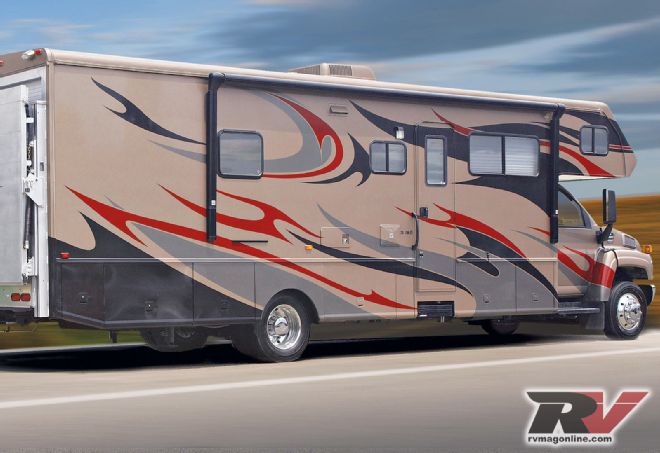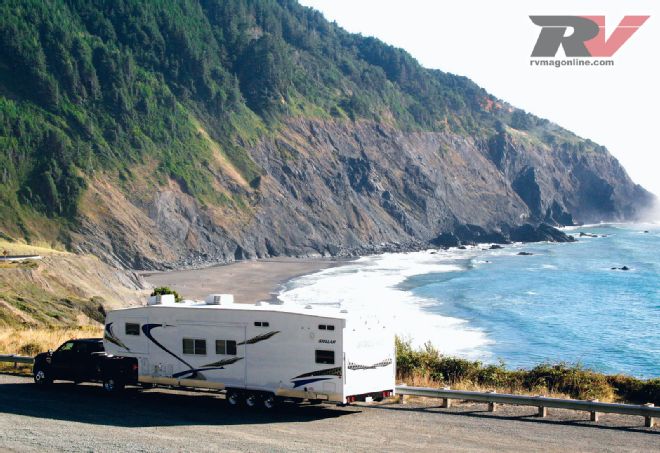
| 0812rv 01 Towing Tips Advice Towing
Before you tow, know the basics. Hitching up can instantly transform your 1-ton truck into a 15-ton wrecking ball. Doing 60 down the interstate is not a good time to learn from your mistakes. A quick education can ensure your safety-and the safety of those around you.
Safe towing starts with a hardy helping of acronym soup. It's critical to understand how weight impacts your tow vehicle and trailer. Here goes:
Gross vehicle weight rating (GVWR) is the maximum your vehicle can weigh (including passengers and cargo) as determined by its manufacturer. Gross trailer weight (GTW) is the total weight of your trailer plus all the cargo you'll be pulling.
Seek out a commercial (truck) scale to weigh both your vehicle and trailer individually (fully loaded as you plan to use them). Long before you purchased your vehicle, its manufacturer determined a maximum weight capacity. Ditto your trailer. Make sure you haven't exceeded these numbers (commonly found in the owner's manual).
Now add the GVWR to the GTW. This is your gross combined weight rating (GCWR). Does your GCWR exceed the vehicle's maximum GCWR? No? Good. Just one more step.
Tongue weight (TW) is the downward pressure applied on the hitch ball by the trailer. Surprisingly enough, you can use a common bathroom scale to measure TW. Just be sure the trailer is level and the wheels chocked when you do this. If the TW is no more than 10 percent of the GTW-congratulations, you're ready to pick a hitch.
Which Hitch Do I Buy?
Toting your powerboat to the marina? Not with that Class I receiver. Just as there's a tool for every job, there's a hitch for every occasion.
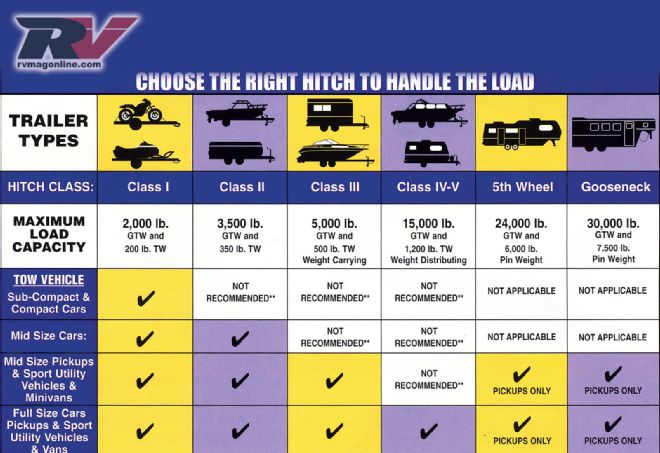
| Most compact cars can manage up to 2,000 pounds. Small trucks and midsize sedans can negotiate about twice that.
Receiver hitches-attached to the frame at the rear of the vehicle-are the most common and are divided into five classes. The more weight you tow, the higher-class hitch you'll need. A Class I hitch can tackle ATVs and jet skis, while you'll need a Class V to negotiate a 12,000-pound camper. Gooseneck and fifth-wheel hitches, mounted inside the truck bed, are for towing only the heaviest loads, including horse trailers and full-size campers up to 30,000 pounds.
You're only as safe as your weakest link. Just because you have a 20K fifth-wheel hitch, it doesn't mean you can tow 20,000 pounds safely. Your vehicle is a big determining factor in your hitch pick. Remember, it can't tow more than it's rated for, regardless of the strength of the hitch.
Most compact cars can manage up to 2,000 pounds. Small trucks and midsize sedans can negotiate about twice that. Large trucks and SUVs max out around 15,000 pounds. If your trailer tips the scales at 16,000 pounds or more, you'll need a purpose-built pickup like the Ford Power Stroke, GMC Duramax or Dodge Cummins diesel. Nowadays, special "tow packages" are also available on most new trucks to cater to habitual heavy-duty haulers.
Also know that not all hitches are created equal. Exact specifications vary from manufacturer to manufacturer. Choose carefully once you're certain of your requirements. Most manufacturers help by presenting the customer with an easy-to-read chart that outlines appropriate hitches based on vehicle and trailer type.
Load It Up
Properly loading your trailer is one of the most commonly overlooked aspects of safe towing. Having the right vehicle, trailer and hitch can go for naught if your cargo configuration is not kosher.
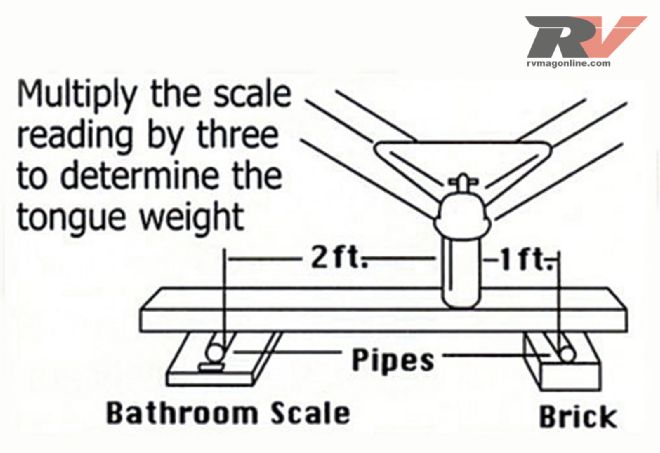
| Tongue weight (TW) is the downward pressure applied on the hitch ball by the trailer. Surprisingly enough, you can use a common bathroom scale to measure TW (as illustrated).
Roughly two thirds (60-66 percent) of the gross load weight should be positioned toward the front half of the trailer. Situate large or heavy objects on the trailer first. Tie these objects down securely from several angles using a strap system. Rope and nylon cord can fray or sever as it rubs on sharp edges during transportation.
Pack remaining items in a manner that maintains balance of the trailer, placing delicate or important objects away from cargo that may shift (and smash!) in transit. Once your trailer is loaded, double-check the positioning and stability of your cargo. Better safe than sorry.
Drive It Like You Didn't Steal It
The last we checked, there is no National Speed Towing Association, and for good reason. Slow and steady is the key. If you've driven on snow or ice, you'll find many of the same rules apply.
Avoid sudden starts, stops and maneuvers that can cause the vehicle to skid or the trailer to fishtail. When starting out, accelerate slowly in the gear designated by your vehicle manufacturer for towing (ever wonder why there's a "1" and "2" on your gearshift anyway?). Drive at modest speeds as not to place undue stress on your engine or transmission (both are expensive to repair).
Maintain an extra cushion of space between you and the vehicles around you. Try to anticipate braking events or the need to slow down, understanding your vehicle must stop considerably more weight than usual. Downshift to help reduce speed.
Signal turns and lane changes well in advance, passing only on level ground and never on a "soft" shoulder. Make wider turns than normal, visualizing the turn in advance.
Do not park on a sloping surface if at all possible. For automatic-transmission vehicles, engage the parking brake first, shift to "park," then release your foot from the brake pedal. For manual transmissions, apply the parking brake and then turn the vehicle off in either "first" or "reverse." Finally, set chocks in front of and behind each trailer wheel.
The More You Know, The Better You Tow
Each state has its own laws governing the use of electric trailer brakes. Brakes are generally required for trailers with a gross weight of 3,000 pounds or more, though the minimum requirement in many states is 1,000 pounds. Trailer brakes are usually controlled by a "brake controller" that's mounted inside the cab of the tow vehicle. Other trailers have hydraulic surge brakes-though some states prohibit the use of surge breaks (hey, take it up with them, we're just the messenger!).
Trailer breakaway kits automatically apply power to the trailer brakes in the event the trailer becomes separated from the tow vehicle. Many states now mandate the installation of a trailer breakaway system. Consult the Department of Motor Vehicles for the laws that apply in your state.
When you are planning an RV trip, be aware of restrictions that limit the transportation of propane gas and other volatile substances in tunnels. Also, some states require additional side- and rearview mirrors on the tow vehicle.
Your vehicle's tires may require higher air pressures for towing heavy loads. Be sure to keep all tires-including those on your trailer-inflated to the proper pressure. Replace worn tires with a tire of the same type, size and construction-do not mix bias-belted and radial tires.
Continuing Education
More information is readily available online. Google "Towing Tips," and you'll generate more than 1.3 million results. As well, most hitch manufacturers and RV associations publish some manner of guide to better, safer towing. A world of knowledge awaits those who seek it.
 | 0812rv 01 Towing Tips Advice Towing
Before you tow, know the basics. Hitching up can instantly transform your 1-ton truck into a 15-ton wrecking ball. Doing 60 down the interstate is not a good time to learn from your mistakes. A quick education can ensure your safety-and the safety of those around you.
Safe towing starts with a hardy helping of acronym soup. It's critical to understand how weight impacts your tow vehicle and trailer. Here goes:
Gross vehicle weight rating (GVWR) is the maximum your vehicle can weigh (including passengers and cargo) as determined by its manufacturer. Gross trailer weight (GTW) is the total weight of your trailer plus all the cargo you'll be pulling.
Seek out a commercial (truck) scale to weigh both your vehicle and trailer individually (fully loaded as you plan to use them). Long before you purchased your vehicle, its manufacturer determined a maximum weight capacity. Ditto your trailer. Make sure you haven't exceeded these numbers (commonly found in the owner's manual).
Now add the GVWR to the GTW. This is your gross combined weight rating (GCWR). Does your GCWR exceed the vehicle's maximum GCWR? No? Good. Just one more step.
Tongue weight (TW) is the downward pressure applied on the hitch ball by the trailer. Surprisingly enough, you can use a common bathroom scale to measure TW. Just be sure the trailer is level and the wheels chocked when you do this. If the TW is no more than 10 percent of the GTW-congratulations, you're ready to pick a hitch.
Which Hitch Do I Buy?
| 0812rv 01 Towing Tips Advice Towing
Before you tow, know the basics. Hitching up can instantly transform your 1-ton truck into a 15-ton wrecking ball. Doing 60 down the interstate is not a good time to learn from your mistakes. A quick education can ensure your safety-and the safety of those around you.
Safe towing starts with a hardy helping of acronym soup. It's critical to understand how weight impacts your tow vehicle and trailer. Here goes:
Gross vehicle weight rating (GVWR) is the maximum your vehicle can weigh (including passengers and cargo) as determined by its manufacturer. Gross trailer weight (GTW) is the total weight of your trailer plus all the cargo you'll be pulling.
Seek out a commercial (truck) scale to weigh both your vehicle and trailer individually (fully loaded as you plan to use them). Long before you purchased your vehicle, its manufacturer determined a maximum weight capacity. Ditto your trailer. Make sure you haven't exceeded these numbers (commonly found in the owner's manual).
Now add the GVWR to the GTW. This is your gross combined weight rating (GCWR). Does your GCWR exceed the vehicle's maximum GCWR? No? Good. Just one more step.
Tongue weight (TW) is the downward pressure applied on the hitch ball by the trailer. Surprisingly enough, you can use a common bathroom scale to measure TW. Just be sure the trailer is level and the wheels chocked when you do this. If the TW is no more than 10 percent of the GTW-congratulations, you're ready to pick a hitch.
Which Hitch Do I Buy? | Most compact cars can manage up to 2,000 pounds. Small trucks and midsize sedans can negotiate about twice that.
Receiver hitches-attached to the frame at the rear of the vehicle-are the most common and are divided into five classes. The more weight you tow, the higher-class hitch you'll need. A Class I hitch can tackle ATVs and jet skis, while you'll need a Class V to negotiate a 12,000-pound camper. Gooseneck and fifth-wheel hitches, mounted inside the truck bed, are for towing only the heaviest loads, including horse trailers and full-size campers up to 30,000 pounds.
You're only as safe as your weakest link. Just because you have a 20K fifth-wheel hitch, it doesn't mean you can tow 20,000 pounds safely. Your vehicle is a big determining factor in your hitch pick. Remember, it can't tow more than it's rated for, regardless of the strength of the hitch.
Most compact cars can manage up to 2,000 pounds. Small trucks and midsize sedans can negotiate about twice that. Large trucks and SUVs max out around 15,000 pounds. If your trailer tips the scales at 16,000 pounds or more, you'll need a purpose-built pickup like the Ford Power Stroke, GMC Duramax or Dodge Cummins diesel. Nowadays, special "tow packages" are also available on most new trucks to cater to habitual heavy-duty haulers.
Also know that not all hitches are created equal. Exact specifications vary from manufacturer to manufacturer. Choose carefully once you're certain of your requirements. Most manufacturers help by presenting the customer with an easy-to-read chart that outlines appropriate hitches based on vehicle and trailer type.
Load It Up
| Most compact cars can manage up to 2,000 pounds. Small trucks and midsize sedans can negotiate about twice that.
Receiver hitches-attached to the frame at the rear of the vehicle-are the most common and are divided into five classes. The more weight you tow, the higher-class hitch you'll need. A Class I hitch can tackle ATVs and jet skis, while you'll need a Class V to negotiate a 12,000-pound camper. Gooseneck and fifth-wheel hitches, mounted inside the truck bed, are for towing only the heaviest loads, including horse trailers and full-size campers up to 30,000 pounds.
You're only as safe as your weakest link. Just because you have a 20K fifth-wheel hitch, it doesn't mean you can tow 20,000 pounds safely. Your vehicle is a big determining factor in your hitch pick. Remember, it can't tow more than it's rated for, regardless of the strength of the hitch.
Most compact cars can manage up to 2,000 pounds. Small trucks and midsize sedans can negotiate about twice that. Large trucks and SUVs max out around 15,000 pounds. If your trailer tips the scales at 16,000 pounds or more, you'll need a purpose-built pickup like the Ford Power Stroke, GMC Duramax or Dodge Cummins diesel. Nowadays, special "tow packages" are also available on most new trucks to cater to habitual heavy-duty haulers.
Also know that not all hitches are created equal. Exact specifications vary from manufacturer to manufacturer. Choose carefully once you're certain of your requirements. Most manufacturers help by presenting the customer with an easy-to-read chart that outlines appropriate hitches based on vehicle and trailer type.
Load It Up | Tongue weight (TW) is the downward pressure applied on the hitch ball by the trailer. Surprisingly enough, you can use a common bathroom scale to measure TW (as illustrated).
Roughly two thirds (60-66 percent) of the gross load weight should be positioned toward the front half of the trailer. Situate large or heavy objects on the trailer first. Tie these objects down securely from several angles using a strap system. Rope and nylon cord can fray or sever as it rubs on sharp edges during transportation.
Pack remaining items in a manner that maintains balance of the trailer, placing delicate or important objects away from cargo that may shift (and smash!) in transit. Once your trailer is loaded, double-check the positioning and stability of your cargo. Better safe than sorry.
Drive It Like You Didn't Steal It
| Tongue weight (TW) is the downward pressure applied on the hitch ball by the trailer. Surprisingly enough, you can use a common bathroom scale to measure TW (as illustrated).
Roughly two thirds (60-66 percent) of the gross load weight should be positioned toward the front half of the trailer. Situate large or heavy objects on the trailer first. Tie these objects down securely from several angles using a strap system. Rope and nylon cord can fray or sever as it rubs on sharp edges during transportation.
Pack remaining items in a manner that maintains balance of the trailer, placing delicate or important objects away from cargo that may shift (and smash!) in transit. Once your trailer is loaded, double-check the positioning and stability of your cargo. Better safe than sorry.
Drive It Like You Didn't Steal It